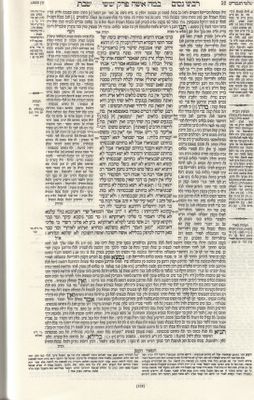
HIDE/SHOW IMAGE
26b
{Shabbat 58a continues}
and the halacha is like Rabbi Abahu, for there is a brayta like him.
And the explanation of kipa shel tzemer {what we've been calling a wool hair-net} are twisted threads of wool, and they make from them a strip of cloth which is two fingerbreadths wide, like the tzitz, as we say {in Chullin 138a}: a kippa shel tzemer rested on the head of the Kohen Gadol, and upon it the tzitz was placed, since it is stated {Shemot 28:37}:
{Shabbat 57b}
{We had said in the brayta: A woman may go out into a courtyard with a kabul and a clasp [itztema]}.
What is an itztema?
Rabbi Abahu said: bei zaynei {our gemara Bizyune}.
Whare is bei zaynei?
That which imprisons the flying [locks]. {Soncino: i.e. a clasp or buckle - as we will now see, the Rif does not render this a clasp.}
By way of explanation, a cloth that they hang from it different types of dyed {strands}, such as a blanket {veil?} that they hang for a bride to remove from her flies, for if a fly lands on her face she would be embarrassed to bother it, and it was cause he anguish - like this that they hang for an animal - and therefore, there is not in it any problem of kilayim, for it is not woven, and it does not become ritually impure with negaim, for it lacks warp and woof, and one may not go out with it into the public domain, for it is not an ornament.
The Sages learnt {in a brayta}: Three things were said of an itztema: there is not in it any problem of kilayim, for it is not woven, and it does not become ritually impure with negaim, for it lacks warp and woof, and one may not go out with it into the public domain, for it is not an ornament. {The reasoning for each of these we lack in the girsa in our gemara.} On the authority of Rabbi Eliezer bar Rabbi Shimon {our gemara: simply Rabbi Shimon}it was said: It is also not subject to [the interdict against] bridal crowns.
{The wearing of bridal crowns was forbidden as a sign of mourning for the destruction of the Temple}
{Shabbat 58a}
Shmuel said: A slave may go out with a seal round his neck {this equals the slave chain mentioned earlier}, but not with a seal on his garments.
A brayta also said so: A slave may go out with a seal round his neck but not with a seal on his garments.
And I will object {from a brayta which contradicts this}: A slave may not go out with the seal around his neck, nor with the seal on his garments {the brayta continues in the gemara}.
This is not a question.
This that learns that he may not go out refers to a metal [seal] while the one that learns that he may go out refers to a clay [seal]. And it is like Rav Nachman.
For Rav Nachman cited Rabba bar Avuah: That about which the master is particular {on account of its value}, one [a slave] may not go out with it; that about which the master is not particular, one may go out with it.
They learnt {tana - in the same brayta}: An animal may not go out with a seal around its neck nor with a seal on its covering, nor with the bell on its covering nor with the bell around its neck.
{Shabbat 59a}
"NOR WITH A GOLDEN CITY":
What is a golden city?
Rabba bar bar Chana said {in our gemara, cited Rabbi Yochanan}: A golden Jerusalem {an ornament with the picture or the engraving of Jerusalem}.
{Shabbat 59b}
such as Rabbi Akiva made for his wife {see Nedarim 50a}.
As for a kalila {coronet - a wreath or chaplet worn on the forehead. Some were entirely of gold or silver; others of silk shot through with gold or silver}:
Rav forbids
And Shmuel permits.
{Note: in the following two paragraphs, I follow Soncino's translation of רוקתא and ניסכא for convenience, but the Rif actually defines these terms on the next page, so check it out.}
Where it is made of ניסכא - cast metal, all agree that it is forbidden. They differ about רוקתא - an embroidered stuff {where the chaplet or coronet is of a stuff with gold or silver embroidery, which would contain pieces of cast metal too}. One Master holds that the cast metal [sewn on to it] is the chief part; while the other Master holds that the embroidered stuff is the chief part.
Rav Ashi learned the above in a way that is more lenient:
As for an embroidered stuff, all agree that it is permitted. They differ only about what is made of cast metal: one Master holds [that it is forbidden] lest she remove it in order to show, and [thus] come to carry it; while the other Master holds: Whose practice is it to go out with a coronet? That of a woman of rank; and such will not remove it for display.



No comments:
Post a Comment